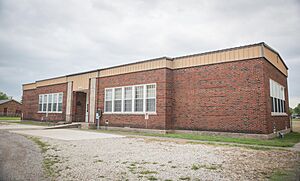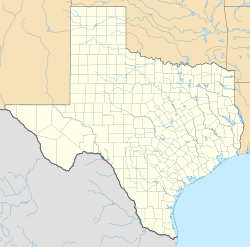Bristol, Texas facts for kids
Quick facts for kids
Bristol
Formerly Heelstring and Brockville
|
|
|---|---|

Bristol School, April 2023
|
|
| Nickname(s):
The Bluebonnet Capitol of Texas!
|
|
| Country | |
| State | |
| County | Ellis |
| Area | |
| • Total | 5.88 sq mi (15.2 km2) |
| • Land | 5.78 sq mi (15.0 km2) |
| • Water | 0.10 sq mi (0.3 km2) |
| Elevation | 486 ft (148 m) |
| Population
(2010)
|
|
| • Total | 668 |
| • Density | 113.61/sq mi (43.86/km2) |
| Time zone | UTC-6 (Central) |
| • Summer (DST) | UTC-5 (Central) |
| ZIP code |
75119
|
| Area code(s) | 972 |
| GNIS feature ID | 2586912 |
Bristol is a small community in Ellis County, Texas, in the United States. In 2010, about 668 people lived there. It's known as a "census-designated place" (CDP), which means it's an area the government counts for population, but it's not officially a city or town with its own local government.
Contents
Where is Bristol Located?
Bristol is found in the northeastern part of Ellis County, Texas. It's about six miles northeast of a town called Palmer. It's also about eighteen miles northeast of Waxahachie. This area is part of the larger Dallas–Fort Worth metroplex, which is a big group of cities and towns.
Bristol's Size and Roads
The community covers about 5.88 square miles (15.2 km2). Most of this area is land, with a small amount of water. Farm to Market Road 660 is an important road that connects Bristol to other towns like Ennis, Palmer, and Ferris.
Bristol's History
Bristol has a long and interesting history, starting way back in the 1840s.
Early Settlements and Names
The area was first settled in the 1840s by a person named Joshua Brock, who came from Missouri. The community was first called Brockville. It even had a post office under that name from 1854 to 1869. Joshua Brock was the first postmaster. Later, people sometimes unofficially called the community Heelstring. The original town was located near the Trinity River, in an area locals still call the "River Bottoms." Sadly, a fire destroyed the town in the late 1800s, so it was moved to its current location.
How Bristol Got Its Name
Years later, a person named Captain Steven Mills came to the area and opened a store. He had done business in Bristol, England, and he liked the name so much that he named his new store "Bristol." Over time, the entire community started using the name Bristol.
By 1890, Bristol had grown into a farming community with about 200 residents. The population grew to around 300 people in the early 1930s. After that, the number of people living there slowly decreased. Today, Bristol still helps local farmers and beef ranches by providing supplies and services.
Bristol as a Census-Designated Place
In 2010, the U.S. Census Bureau officially named Bristol a "census-designated place" (CDP). This means that the boundaries for counting people include the original community of Bristol and the areas around it.
Community Events
Even though it's a small community, Bristol is a lively place! They hold several fun events throughout the year. These include the monthly Bristol Opry, a big 4th of July Celebration, an Easter Bunny Breakfast, and a Thanksgiving Dinner.
Who Lives in Bristol?
| Historical population | |||
|---|---|---|---|
| Census | Pop. | %± | |
| 2010 | 668 | — | |
| U.S. Decennial Census 1850–1900 1910 1920 1930 1940 1950 1960 1970 1980 1990 2000 2010 |
|||
In 2010, there were 668 people living in Bristol. These people lived in 239 different homes, and 188 of those were families. Most of the people living in Bristol were White. There were also people from other backgrounds, including African American, Native American, and Asian people. About 14.8% of the population identified as Hispanic or Latino.
Learning in Bristol
Education has always been important in Bristol.
Early Schools
The first school in Bristol was in a building built in 1870 that served many purposes. The Bristol Rural School District was officially started in 1877. Kids from all over the area went to the Bristol schoolhouse, which was built in 1886 and again in 1913.
A new brick school building was finished in 1939. It had five classrooms, an auditorium, and a stage. This school was built with help from the U.S. Works Progress Administration (WPA), a program that created jobs during tough economic times. In the 1940-41 school year, 130 students attended this school, which had nine grades and six teachers. Bristol High School even had basketball and baseball teams, plus a 4-H club! The school served the community until 1955. In 1957, the school's buildings and land were given to the Bristol Cemetery Association. Today, the old school building is used as a community center for the town.
Current School Districts
Currently, students in the Bristol area attend schools in a few different school districts. These include the Ennis Independent School District, the Ferris Independent School District, and the Palmer Independent School District.
Cemeteries
Bristol has three cemeteries. The largest one, which is still used today, is the Bristol Cemetery. It's located right in town and is managed by the Bristol Cemetery Association.
Two older cemeteries are the Hefley Pioneer Cemetery, located on Slate Rock Road, and Union Hill Cemetery, located on Union Hill Road. Union Hill Cemetery was a burial place for Union soldiers during the Civil War. Local volunteers help take care of both of these historic cemeteries.
See also
 In Spanish: Bristol (Texas) para niños
In Spanish: Bristol (Texas) para niños


